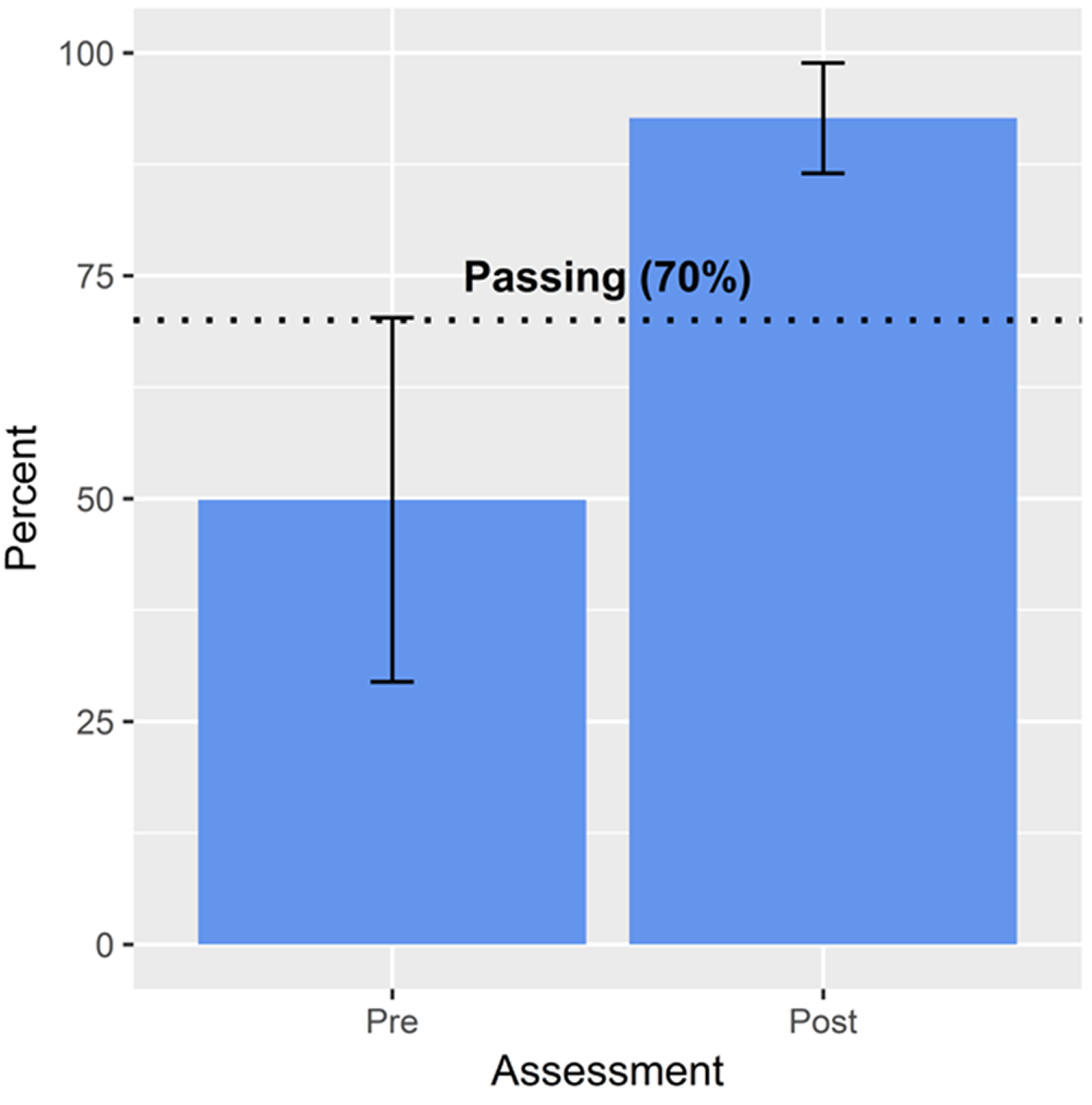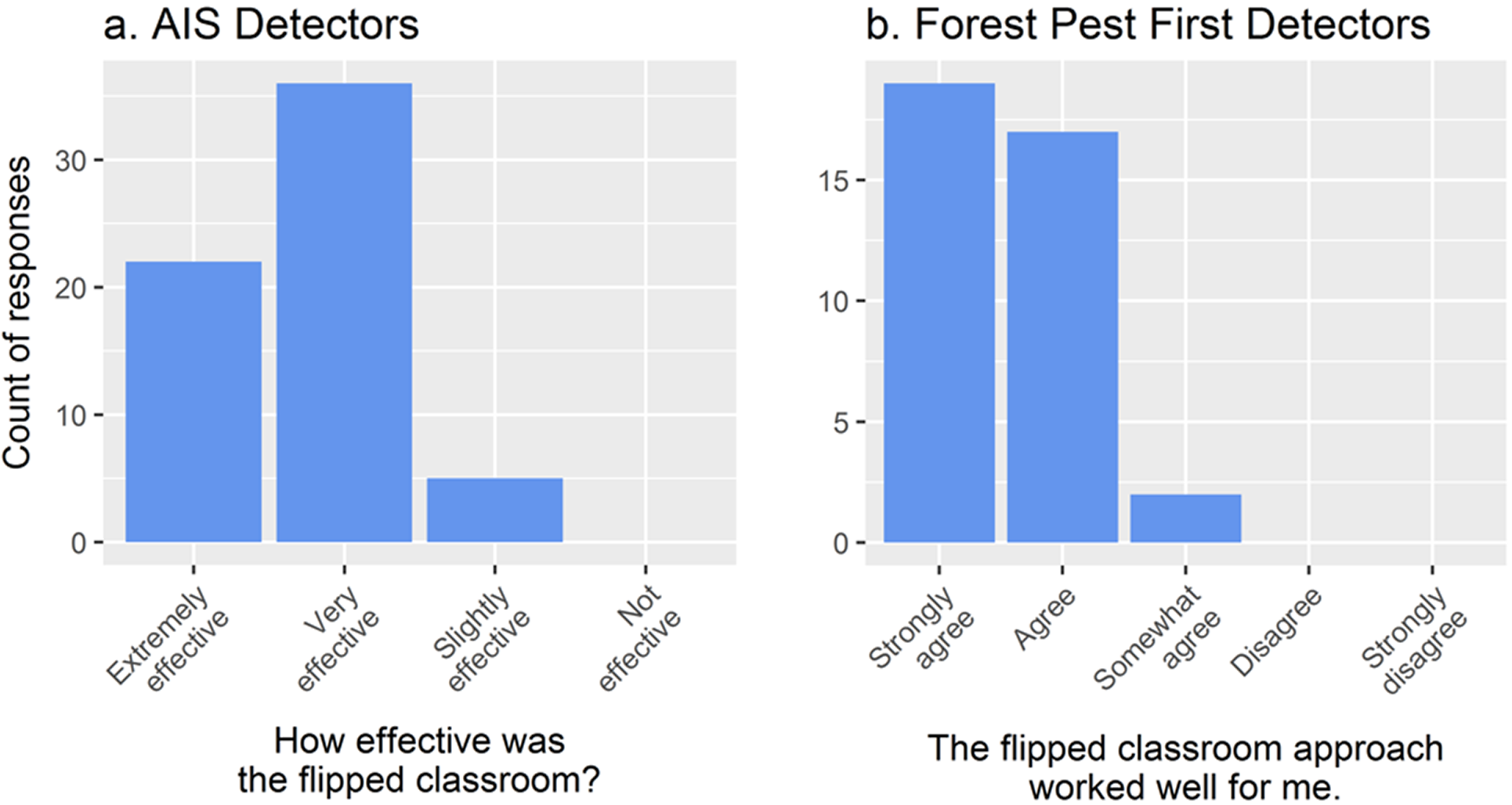 |
September
2018
|
September 2018 // Volume 56 // Number 5 // Tools of the Trade // v56-5tt1
Flipping the Classroom to Train Citizen Scientists in Invasive Species Detection and Response
Abstract
Extension educators are increasingly using flipped classrooms, wherein online content delivery precedes in-person learning. We have applied this approach to two Extension programs in which citizen scientists are trained in early detection of invasive species. Our goal in using the tool of flipped classrooms is to accommodate large amounts of content while focusing classroom time on skills development. In 2017, we assessed efficacy of the flipped classroom through knowledge tests and surveys completed by 174 participants and 106 participants, respectively. Results demonstrated large knowledge gains and high participant satisfaction. We encourage Extension professionals to consider whether use of the flipped classroom format could advance achievement of their programs' learning objectives.
Introduction
Research on adult learners has identified key differences between adult and traditional student–aged audiences (Knowles, 1980; Merriam, 2001), providing blueprints for effective andragogy in Extension programming (Strong, Harder, & Carter, 2010). In particular, adult learners have greater capacity to direct their own learning, have problem-oriented learning goals, wish to immediately apply new knowledge, and are more self-motivated than externally motivated (Knowles, 1980).
These characteristics of adult learners align well with flipped classroom teaching methods. In this format, the traditional in-class lecture components of teaching occur prior to face-to-face meetings via self-paced, independent learning focused on knowledge and comprehension (Anderson & Krathwohl, 2001; Milman, 2012), freeing in-class time for higher level, more active modes of learning that leverage the presence of instructors and peers to facilitate application, analysis, and synthesis (Anderson & Krathwohl, 2001; Mazur, 2009).
Researchers have advocated the flipped classroom as a means for improving Extension programming. Strong, Rowntree, Thurlow, and Raven (2015) argued for more community-centric rather than content-centric approaches to Extension and cited the flipped classroom as a tool for advancing that shift. Others have documented the efficacy of flipped classroom approaches in Extension for internal staff development (Burns & Schroeder, 2014; Franz, Brekke, Coates, Kress, & Hlas, 2014) and youth programs (Garst, Baughman, & Franz, 2014; Weitzenkamp, Dam, & Chichester, 2015).
We employed flipped classrooms in two University of Minnesota Extension programs focused on increasing capacity for invasive species early detection and rapid response through citizen science. We used flipped classrooms to accommodate the large amount of content delivery these programs required and to reserve face-to-face time for participants to practice, implement, and demonstrate competency with newly gained knowledge and tools.
Descriptions of Programs
AIS Detectors (AISD) (www.aisdetectors.org) targets detection and control of plant and animal aquatic invasive species (AIS) and was launched in the flipped classroom format in spring 2017. Forest Pest First Detectors (FPFD) (www.myminnesotawoods.umn.edu/forest-pest-first-detector/), which focuses on terrestrial invasive insects and plants, had launched in 2008 and was switched to the flipped classroom format in spring 2017. Both programs engage adults as citizen science volunteers and place high expectations on participants' capacity to (a) identify numerous invasive species and native look-alikes, (b) use a smartphone app to report suspected new infestations, and (c) communicate responsibly and effectively with professionals from resource management agencies and the public.
Evaluation of Flipped Classroom Effectiveness
We used knowledge tests and participant surveys to evaluate the effectiveness of the flipped classroom approach for participants in seven AISD workshops and two FPFD workshops held across Minnesota in spring 2017. For AISD, we tested participants' understanding of key issues and concepts at three time points through testing administered before and after exposure to the online curriculum and a postworkshop knowledge exam. For FPFD, we assessed content knowledge through testing administered after the online curriculum. In addition, we used postworkshop online surveys, created via Qualtrics online survey software, to solicit anonymous evaluations from participants. For AISD, we asked students to rate the effectiveness of the flipped classroom format using a multiple-choice question and sought comments through an open-ended question. For FPFD, we used a multiple-choice question to gauge participant agreement with the statement "The flipped classroom approach worked well for me." Additionally, in response to a general request for comments, several participants commented on the flipped classroom.
Results from knowledge testing of 174 participants (AISD n = 123, FPFD n = 51) and survey responses from 106 participants (AISD n = 66, FPFD n = 40) showed the flipped classroom to be highly effective. For AISD, testing indicated that prior to completing the online curriculum, only 18% of participants had satisfactory knowledge of AIS (based on a passing grade of 70%). After completion of the online curriculum, all participants passed (M = 93%) (Figure 1). In the AISD postworkshop exam, all but one participant passed (M = 88%), the lone exception being the only person who had not completed the online curriculum. For FPFD, all participants scored 95% or higher on knowledge assessments following completion of the online curriculum.
Figure 1.
Before-and-After Assessment of Knowledge Gain Related to the AIS Detectors Program's Online Curriculum

Note: Bars show means; error bars are ±1 standard deviation.
Participants also reported high satisfaction with the format: 92% of AISD respondents considered the format to be very or extremely effective; 95% of FPFD survey respondents agreed or strongly agreed that the flipped classroom approach worked well for them (Figure 2).
Figure 2.
Summary of Participant Evaluations of the Effectiveness of the Flipped Classroom Approach

Participants' qualitative survey responses highlighted factors that contributed to their satisfaction with the flipped classroom format. In particular, participants reported that the flipped classroom helped them understand the material, enjoy the learning experience, and make the most of their in-person time (Table 1).
| Program | Participant comments |
| AISD | Knowing the material before class actually makes the class more productive. Not concerned as much about learning the material because you know the basics. Because of this you can ask better questions that will expand your knowledge. |
| It was much more interactive and thus easier to learn the material. It is hard to listen through and retain knowledge from multiple PowerPoint presentations. | |
| It was very well done! No boredom whatsoever! | |
| FPFD | I really benefited from the flipped classroom approach and enjoyed the small group sessions. |
| Loved it. Much more conducive to really learning and using the material. | |
| I really liked this format better and enjoyed the small group discussions upstairs. | |
| Note. AISD = AIS [Aquatic Invasive Species] Detectors program. FPFD = Forest Pest First Detectors program. | |
Conclusion
Extension professionals are increasingly using the flipped classroom in their programming. We found it to be an effective and enjoyable means of teaching challenging content to adult learners and training them to implement new skills. In particular, it allowed us to make the most of our limited in-person time with participants. We encourage others in Extension to ask whether a flipped classroom could benefit their programs and to consider this approach when designing new courses or updating existing ones.
Acknowledgments
Funding for our research was provided through the Minnesota Aquatic Invasive Species Research Center from the Minnesota Environment and Natural Resources Trust Fund and from partner organizations and in-kind support. We thank the AIS Detectors and Forest Pest First Detectors for their participation and feedback.
References
Anderson, L. W., & Krathwohl, D. R. (2001). A taxonomy for learning, teaching and assessing: A revision of Bloom's taxonomy. New York, NY: Longman Publishing.
Burns, C. S., & Schroeder, M. M. (2014). Are you ready to flip? A new approach to staff development. Journal of Extension, 52(5), Article 5IAW4. Available at: https://joe.org/joe/2014october/iw4.php
Franz, N. K., Brekke, R., Coates, D., Kress, C., & Hlas, J. (2014). The virtual Extension annual conference: Addressing contemporary professional development needs. Journal of Extension, 52(1), Article 1TOT1. Available at: https://www.joe.org/joe/2014february/tt1.php
Garst, B. A., Baughman, S., & Franz, N. K. (2014). Benchmarking professional development practices across youth-serving organizations: Implications for Extension. Journal of Extension, 52(5), Article 5FEA2. Available at: https://www.joe.org/joe/2014october/a2.php
Knowles, M. S. (1980). The modern practice of adult education (2nd ed.). New York, NY: Cambridge Books.
Mazur, E. (2009). Farewell, lecture? Science, 323(5910), 50–51.
Merriam, S. B. (2001). Andragogy and self-directed learning: Pillars of adult learning theory. New Directions for Adult and Continuing Education, 2001(89), 3–14.
Milman, N. B. (2012). The flipped classroom strategy: What is it and how can it best be used? Distance Learning, 9(3), 85.
Strong, E., Rowntree, J., Thurlow, K., & Raven, M. R. (2015). The case for a paradigm shift in Extension from information-centric to community-centric programming. Journal of Extension, 53(4), Article 4IAW1. Available at: https://www.joe.org/joe/2015august/iw1.php
Strong, R., Harder, A., & Carter, H. (2010). Agricultural Extension agents' perceptions of effective teaching strategies for adult learners in the master beef producer program. Journal of Extension, 48(3), Article 3RIB2. Available at: https://joe.org/joe/2010june/rb2.php
Weitzenkamp, D., Dam, K., & Chichester, L. (2015). Developing a mobile Extension course for youth livestock producers. Journal of Extension, 53(2), Article 2IAW6. Available at: https://www.joe.org/joe/2015april/iw6.php





